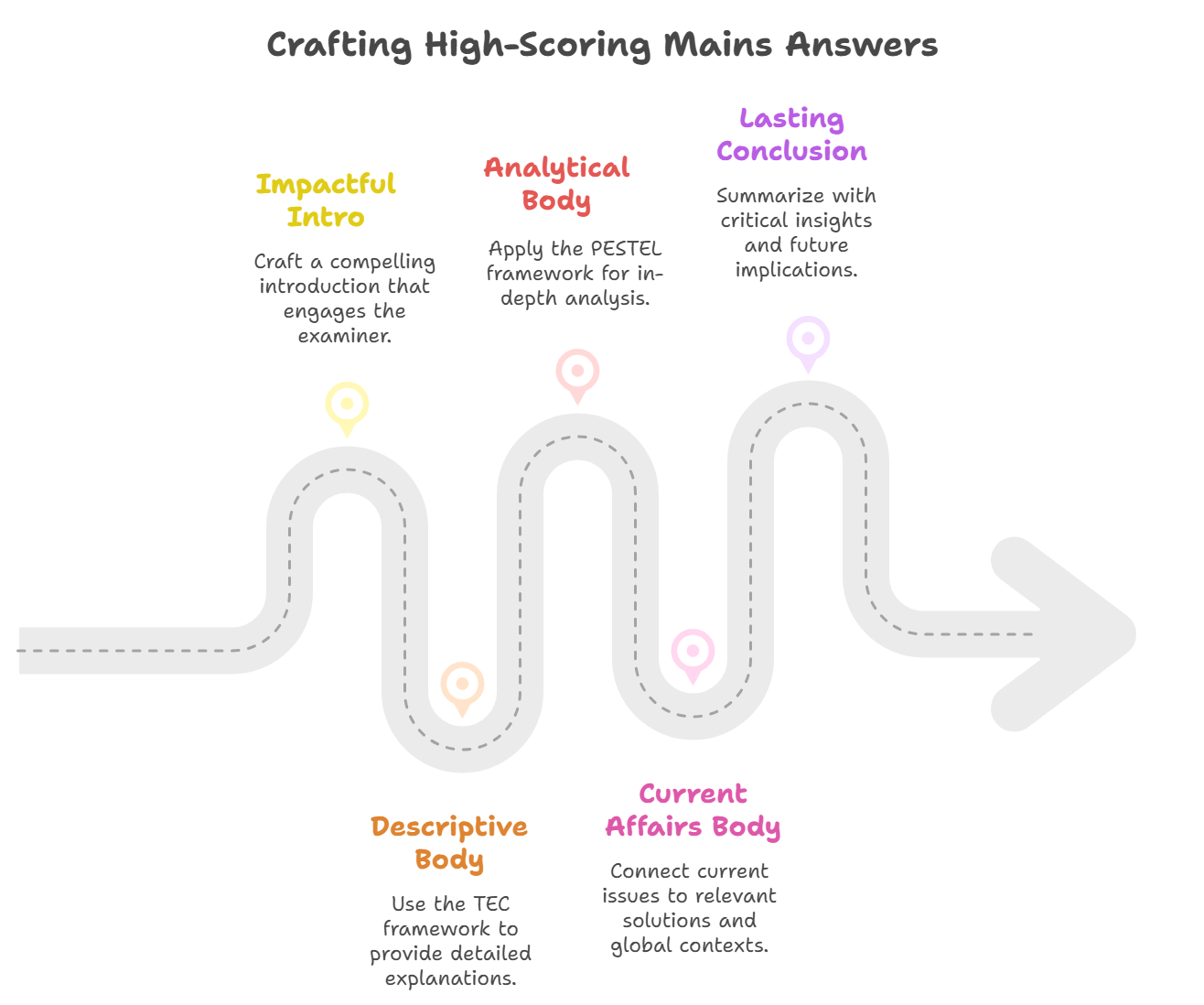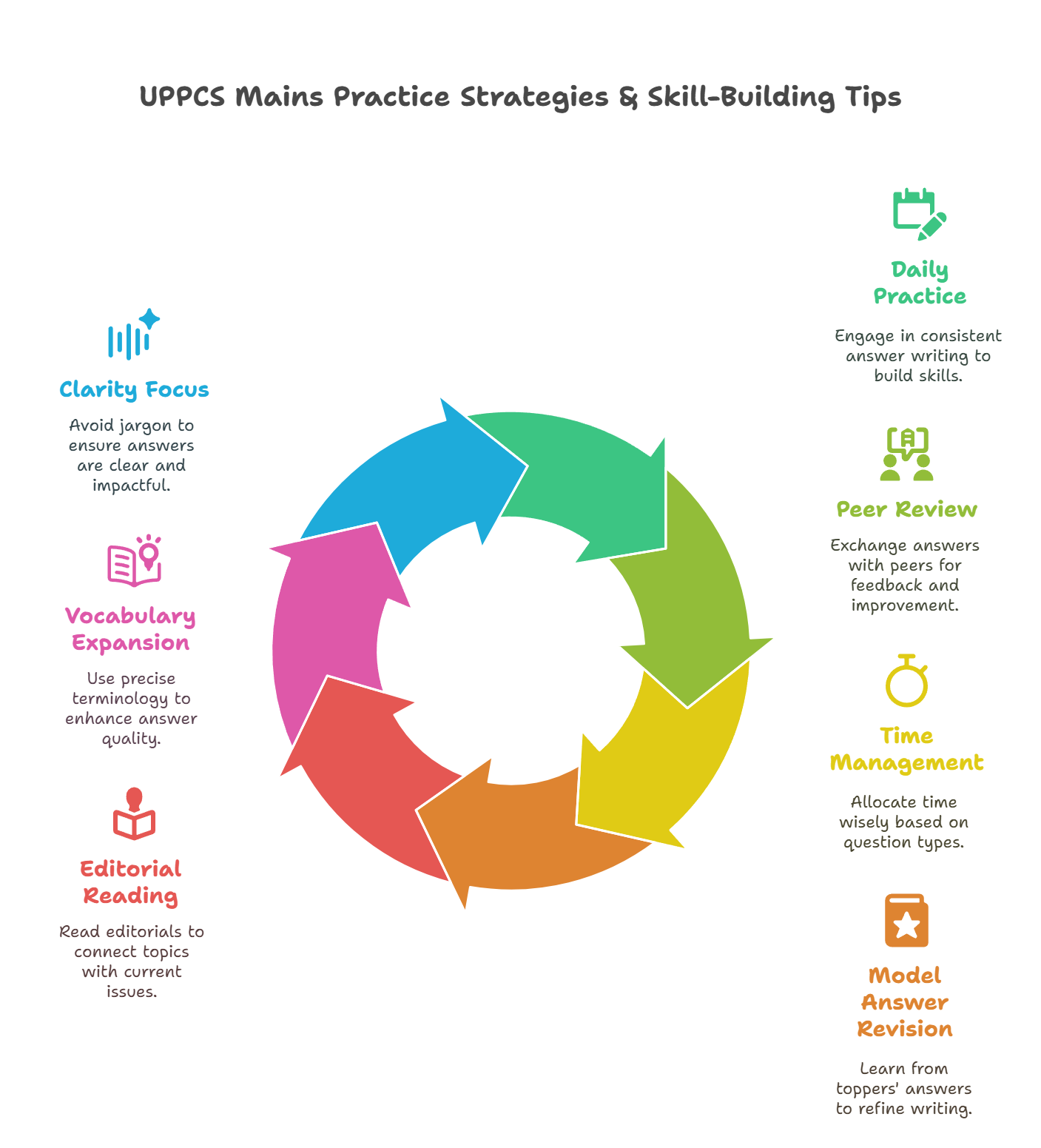How to Structure Your UPPCS Mains Answers for Maximum Marks?
Blogs Home
- 26 Mar 2025

The Mains stage of the Uttar Pradesh Public Service Commission (UPPCS) exam is crucial as it not only evaluates your knowledge but also assesses how effectively you can articulate your answers. With fierce competition among aspirants, your answer-writing skills can be the deciding factor between success and failure.
In this blog we will comprehensively cover the proven strategies to craft high-scoring answers, complete with tips, sample answers, and common pitfalls to avoid.
The Art of Answer Writing in UPPCS Mains
The art of answer writing lies in the way you structure, present, and stay relevant to the demand of the question often becomes the game-changer.The real challenge in UPPCS Mains lies in transforming your knowledge into well-structured, high-impact answers. The Mains exam is an arena where your ability to construct compelling responses sets you apart.
It’s not just about what you know—it’s about how effectively you present it.
Relevance is Non-Negotiable
- Examiners evaluate hundreds of answer scripts daily. If your response deviates from the core demand of the question, a brilliant content won’t save you. Strict adherence to the question’s requirement is essential.
- Example: If a question asks about the “Causes of the 1857 Revolt”, your response should categorize political, economic, and social triggers- not delve into a detailed biography of Rani Lakshmibai.
Presentation is a Game Changer
- A haphazard answer frustrates evaluators. Your thoughts should unfold like a well-structured story- beginning with an introduction, followed by context, key arguments, and a clear conclusion.
- A visually appealing answer sheet can influence how an examiner perceives your response. Neatly underlined headings, bullet points, and quick diagrams, create visual breaks that make evaluation effortless.
Facts Are Armor
- Vague statements which do not substantiate with data and facts, dilute your answer’s impact. Examiners appreciate precision and specificity. Adding relevant data, government reports, and real-life examples strengthens your arguments.
- For Example:
- Weak: “UP has many farmers.”
- Strong: “With 15.9 million operational holdings (Agriculture Census 2015-16), Uttar Pradesh accounts for 18% of India’s agricultural workforce.”
The difference? The second statement exudes credibility and depth, making it more scoring.
The Blueprint to UPPCS Mains Success
Introduction: Setting the Tone and Relevance for the Answer (10–15%)
- Your introduction sets the tone for the entire answer. Avoid generic statements like “Gandhi was a great leader.” Instead, engage directly with the question using a context-driven and thesis-based approach.
- Example: “Role of Mahatma Gandhi in the Indian Freedom Struggle.”
- Weak Intro: “Gandhi ji was a great leader who fought for freedom.” (Too vague)
- Strong Intro: “Mahatma Gandhi’s doctrine of Satyagraha (1920s–1940s) transformed India’s freedom struggle into a pan-Indian mass movement, uniting peasants, elites, and women under non-violent resistance.”
Pro Tip: Start with a fact, quote, or definition. Eg: “Non-cooperation is a protest against injustice,” declared Gandhi in 1920, launching India’s first nationwide mass movement against British rule.
Body: Delivering Content with Clarity and Depth (70–80%)
- The body forms the analytical core of your answer, it is the section where your understanding, articulation, and command over the subject are most thoroughly evaluated.
A. Analytical Questions (e.g., “Evaluate land reforms in UP”)
- Apply the PESTEL Framework (Political, Economic, Social, Technological, Environmental, Legal):
- Political: Reduced zamindari dominance.
- Economic: Increased agricultural productivity.
- Social: Reduced rural inequality.
- Technological: Limited impact due to lack of modern methods.
- Environmental: Overuse of fertilizers post-Green Revolution.
- Legal: Challenges in implementation of Land Ceiling Acts.
Pro Tip: Use official data from UP government reports. Eg: “UP’s Land Ceiling Act (1960) redistributed 8.2 lakh hectares, benefitting 12 lakh SC/ST families (UP Revenue Department, 2020).”
B. Descriptive Questions (e.g., “Explain the causes of the 1857 Revolt”)
Use the TEC Framework (Thematic, Examples, Consequences):
- Political Causes: Annexation policies (Doctrine of Lapse → Satara, Jhansi).
- Economic Exploitation: High land revenue (50% tax in Ryotwari areas)
- Social-Religious Grievances: Fear of Christianization (General Services Enlistment Act, 1856).
- Pro Tip: Draw a map of revolt centers (Delhi, Lucknow, Kanpur) to earn extra marks.
C. Current Affairs Questions (e.g., “Challenges of urbanization in UP”)
- Approach: Link issues with relevant schemes, case studies, and SDGs.
- Issue: Water scarcity → Jal Jeevan Mission (Target: 100% piped water in urban UP by 2024).
- Case Study: Kanpur’s severe air pollution (AQI 400+ in winters) vs. Varanasi’s Smart City progress.
- Global Linkage: SDG 11 – Sustainable Cities and Communities.
- Pro Tips: Use flowcharts to present solutions clearly.
E.g.: Rapid Urbanization → Waste Crisis → Swachh Bharat Mission → Decentralized Composting.- Use logical connectors like Firstly, Moreover, In conclusion, to maintain coherence and guide the examiner through your answer.
Conclusion: Leave a Lasting Impression (10–15% of the Answer)
- A strong conclusion should reflect critical thinking, not just summarize the answer.
- Effective Conclusion Styles:
- SWOT Analysis: “While Gandhi’s methods ensured mass participation (Strength), their reliance on British morality (Weakness) delayed radical outcomes. Nevertheless, they remain a blueprint for global nonviolent movements (Opportunity).”
- Future-Oriented Approach: “To address urbanization, UP must prioritize affordable housing (Mukhyamantri Awas Yojana) and green infrastructure, aligning with its USD 1 trillion economy vision.”
- Pro Tip: End with a provocative question or quote. Use phrases like “In conclusion,” or “To ensure sustainable progress…” to signal closure.
Must-Know Essentials for UPPCS Mains Answers
Word Limit: Quality Over Quantity
UPPCS Mains GS Papers consists of 20 questions divided into 2 sections, which has to be completed in 3 hrs time duration.
- Section A: 10 Short Answer Questions (8 marks each, 125-word limit), requiring approximately 6-8 minutes per question.
- Section B: 10 Long Answer Questions (12 marks each, 200-word limit), demanding around 9-11 minutes per question.
- Stick to the word limit religiously. Overwriting wastes time and annoys examiners, while underwriting signals incomplete knowledge.
Headings & Subheadings: Your Answer’s Roadmap
- Headings break monotony and help examiners quickly locate key points.
Do’s:
- Use bold or underline headings (e.g., Economic Causes of the 1857 Revolt).
- Follow a hierarchy:
- Main Heading (e.g., Social Impact)
- Subheading (e.g., Caste-Based Discrimination)
- Keep headings concise (3–5 words).
Don’ts:
- Avoid decorative fonts or excessive highlighting.
- Never write headings in red/green ink (stick to blue/black).
- Example Question: “Discuss the effects of globalization on Indian agriculture.”
- Headings:
- Positive Impacts
- Access to Global Markets
- Technology Diffusion
- Negative Impacts
- Farmer Debt Crisis
- Climate Vulnerability
- Positive Impacts
- Headings:
Diagrams: The Silent Marks-Magnet
- Visual aids can fetch 10–15% extra marks if used wisely.
When to Use Diagrams:
- Geography: Maps (e.g., UP’s river systems), climate graphs.
- Science & Tech: Flowcharts (e.g., blockchain workflow), diagrams (e.g., solar panel mechanism).
- Economics: Pie charts (e.g., UP’s GDP composition), bar graphs (e.g., literacy rate trends).
- Pro Tips: Keep diagrams neat and labeled (e.g., “Fig: Uttar Pradesh’s Major Crops”).
- Use a pencil for maps/graphs to avoid ink smudging.
- For 12-mark answers, add 1–2 relevant diagrams.
Daily Answer Writing Drill for UPPCS Mains
Cracking UPPCS Mains isn’t just about what you study—it’s about how you practice. Here’s a battle-tested plan to transform your answer writing from average to exceptional.
Daily Practice: Consistency Beats Talent
You should write 2–3 answers daily (GS, Essay, Optional) to build consistency, improve articulation, and enhance Mains performance.
How to Do It:
- Focus on PYQs: Start with UPPCS Mains previous papers (2015–2023).
- Thematic Clusters: Group similar topics (e.g., Agriculture in UP or Ethics Case Studies).
- Timed Sessions: Use a stopwatch (e.g., 12 minutes for a 12-mark question).
- Track Progress: Maintain a tracker to identify weak areas such as given below:
|
Week |
Topics Covered |
Avg. Time per Answer |
Common Mistakes |
|
1 |
Agriculture, Ethics |
10 mins (12 marks) |
Overwriting, weak conclusions |
|
2 |
Governance, Economy |
7 mins (8 marks) |
Lack of examples, weak intro |
Peer Review: Find Your Blind Spots
Peer review helps identify mistakes and improve answer writing. Joining a study group (online/offline) and exchanging at least two answers weekly with structured feedback on clarity, structure, and accuracy can refine writing skills. Using a simple rating (1–5) for each criterion ensures focused improvement. Debating conflicting feedback further sharpens analytical skills.
Additionally, Drishti IAS’s Daily Mains Answer Writing Initiative provides sample answers for UPPCS/UPSC Mains, allowing students to compare and evaluate their responses effectively.
Time Management: Race Against the Clock
Effective time management is crucial for Mains answer writing. Allocate time wisely based on question types: 7–8 minutes for 8-mark short answers and 10–12 minutes for 12-mark long answers.
To save time, pre-frame introduction and conclusion templates for common topics, use abbreviations (e.g., BR for British Raj, NEP for New Economic Policy), and write in bullet points for direct questions. Regular timed practice ensures speed and precision, helping you complete the paper efficiently.
Revise Model Answers: Learn from the Best
Studying toppers’ copies helps refine answer writing by analyzing structure, keyword usage, and diagram placement. Observe how headings, data, and examples are integrated, and note the use of terms like demographic dividend or cooperative federalism. Simple, well-placed diagrams enhance clarity.
Utilize Drishti IAS’s UPPCS-specific model answers to understand high-scoring strategies. A powerful technique is rewriting a topper’s answer in your own words- this reinforces their approach while improving retention and articulation.
Read Editorials: Sharpen Your Analytical Edge
Regularly reading The Hindu and Indian Express helps connect static topics with current issues (e.g., caste discrimination → Hathras case) and master structured arguments like For vs Against or Ethical vs Practical.
To apply this, read an editorial on Farmers’ Protests and write a 12-mark answer on Challenges of Agricultural Marketing in UP, incorporating key terms like MSP, APMC reforms, and rural credit access. This practice enhances analytical depth and relevance in Mains answers.
Common Mistakes to Avoid in UPPCS Mains Answers Writing
- Ignoring the Question’s Demand: Avoid generic answers—focus on UP-specific data and socio-economic aspects when asked about MNREGA’s impact in Uttar Pradesh. Examiners penalize divergence, so underline keywords (e.g., analyze, socio-economic, UP) to stay on track.
- Overloading with Irrelevant Facts; Adding unrelated data weakens answers. Unnecessary details waste time and dilute relevance. Use the “So What?” Test, ensure every fact directly answers the question.
- Poor Time Management: Overspending time on one answer leads to an incomplete paper and lost marks. Stick to 10 mins for 12 marks, use a stopwatch, and attempt confident questions first.
- Neglecting UP-Specific Examples; Generic answers lower scores in UPPCS. For a question on urbanization in UP, mentioning Mumbai’s slums is irrelevant; instead, cite Kanpur’s AQI 400+ or Varanasi’s drainage issues. UPPCS demands local context, so memorize key UP schemes, demographics, and reports (e.g., UP Economic Survey) for a stronger answer.
Conclusion
Mastering UPPCS Mains answer writing requires consistent practice, smart structuring, and critical analysis. By following this guide, you’ll not only save time in the exam but also present answers that stand out. Success in the UPPCS exam isn’t reserved for geniuses- it’s earned by aspirants who embrace consistency, learn from mistakes and stay curious.

.jpg)
.jpg)



.jpg)



